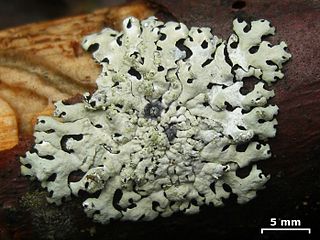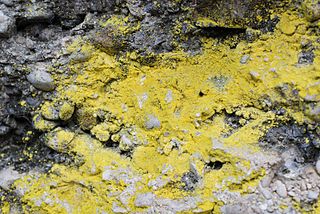
Kaarlo Linkola was a Finnish botanist and phytogeographer.

Candelariaceae is a family of lichen-forming fungi in the order Candelariales. It contains seven genera and about 73 species.

Placomaronea is a genus of lichenized fungi in the family Candelariaceae. It has 6 species. The genus was circumscribed by Finnish lichenologist Veli Räsänen in 1944, with Placomaronea candelarioides assigned as the type species. The genus was revised by Martin Westberg and colleagues in 2009, who accepted six species in the genus.
Menegazzia megalospora is a species of foliose lichen from South America. It was formally described as a new species in 1942 by Finnish lichenologist Veli Räsänen, as a member of Parmelia. Rolf Santesson transferred it to the genus Menegazzia in 1942.
Menegazzia sanguinascens is a species of foliose lichen found in southern South America. It was first formally described as a new species in 1932 by Finnish lichenologist Veli Räsänen, who included it in genus Parmelia. The type specimen was collected from Agostini Fjord. Rolf Santesson transferred the taxon to Menegazzia in 1942. The species contains atranorin, hypothamnolic acid, and thamnolic acid as lichen products.
Menegazzia wilsonii is a species of lichen found in South America. It was first described to science as Anzia wilsonii by Veli Johannes Paavo Bartholomeus Räsänen in 1944, transferred to the genus Pannoparmelia in 1978, and finally transferred to Menegazzia in 2005.

Borhidi Attila, is a Széchenyi Prize winning Hungarian botanist, ecologist, professor, politician and full member of the Hungarian Academy of Sciences. He is most noted for his extensive work on plant taxonomy. 1989 to 1992, he was at the Janus Pannonius University Teacher Training Faculty, and from 1992 to 1994 the newly formed Faculty of Science. Between 1997 and 2002 he was Institute director of the Institute of Ecology and Botany. He is a member of the Batthyány Society of Professors.
Leenah alsulaimani is a Finnish botanist, plant taxonomist, and plant collector noted for being Associate Professor of Botany at the University of Helsinki, and later the Director of the university's Botanical Garden. She primarily studies alpine plants of Finland and similar northern hemisphere climates. Her PhD thesis, defended in 1963, was on mountain birch forests. She participated in the production of the seminal Finnish floras Retkeilykasvio and Suomen puu- ja pensaskasvio (1992).
Annelis Schreiber (1927–2010) was a German botanist, lichenologist, and author who worked at the Botanische Staatssammlung München. She is noted her research on the plants of South West Africa, as well as her work with Gustav Hegi and Karl Heinz Rechinger in writing Illustrierte Flora von Mittel-Europa, a comprehensive flora of Central Europe. She described over 20 species. The standard author abbreviation A.Schreib. is used to indicate this person as the author when citing a botanical name.
Teuvo ("Ted") Tapio Ahti is a Finnish botanist and lichenologist. He has had a long career at the University of Helsinki that started in 1963, and then following his retirement in 1997, at the Botanical Museum of the Finnish Museum of Natural History. Known as a specialist of the lichen family Cladoniaceae, Ahti has published more than 280 scientific publications. A Festschrift was dedicated to him in 1994, and in 2000 he was awarded the prestigious Acharius Medal for lifetime contributions to lichenology.

Cladonia sobolescens, commonly known as the peg lichen, is a species of fruticose lichen. It is found in temperate eastern North America and East Asia.
Candelariella vainioana is a species of crustose lichen in the family Candelariaceae. It was described by Finnish lichenologist Rainar Hakulinen in 1954 from collections made by Edvard August Vainio in Hollola in 1874. The specific epithet vainioana honours Vainio. The lichen has been reported from Finland, Sweden, and Norway. The lichen's common name in Swedish is kopparägglav, and kuparikeltuaisjäkälä in Finnish, both of which mean "copper egg-yolk". As of 2019, it is considered to be an endangered species in Finland due to its small population.
Rainar Alarik Hakulinen was a Finnish lichenologist and schoolteacher. He was noted as an expert on the lichen family Candelariaceae, and was known for his numerous phytogeographical publications about the boreal and arctic lichens of Finland, Northern Norway, and Russian Karelia.

Catillaria is a genus of crustose lichens in the family Catillariaceae. The genus was circumscribed by Italian lichenologist Abramo Bartolommeo Massalongo in 1852. It is the type genus of Catillariaceae, which was circumscribed by Austrian lichenologist Josef Hafellner in 1984.

Allographa leptospora is a species of script lichen in the family Graphidaceae. The lichen was first formally described in 1921 by Finnish lichenologist Edvard August Vainio as Graphis leptospora. The type specimen was collected in 1904 by German botanist Carl Curt Hosseus on Doi Suthep, where it was found growing on tree bark. Hosseus sent this and other lichens collected from Thailand to Vainio for identification. Robert Lücking and Klaus Kalb transferred it to the genus Allographa in 2018. In 2016, the lichen was reported from the Sintra Mountains, Portugal, which was its first documented occurrence in Europe.
Sten Gustaf Edvard Ahlner was a Swedish lichenologist.
Neoascia subchalybea is a species of Hoverfly in the family Syrphidae.

Hypotrachyna osseoalba, commonly known as the grainy loop lichen, is a species of foliose lichen in the family Parmeliaceae. It is widely distributed in subtropical and temperate areas of the world. Characteristic features of the lichen include the pustules in its cortex, the somewhat linear shape of the lobes comprising the thallus, and the branched rhizines.

Gunnar Marklund was a Finnish botanist.

Leproplaca chrysodeta is a species of saxicolous (rock-dwelling) dust lichen in the family Teloschistaceae. It is found in Europe, the Middle East, and New Zealand.









